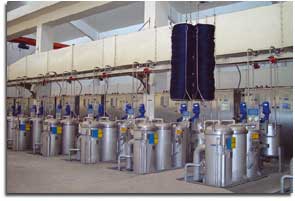Dyeing Machinery
Tops - TCP

These concepts are respected also in the apparatuses type “TCP” which are specialised for the tops dyeing. TCP, can offer both the minimum liquor ratio and the inter-changeability of dyeing spindles between apparatuses of any capacities.
These features lead to less energy and chemical products consumptions, easy management of loading and unloading operations, simplicity of the press loading phase, by working with only one type of spindle for holding the material. For this reason TCP is a modular system.
A further simplification of the tops bobbins or bumps loading/unloading operations is the absence of the external jackets which renders the spindle, composed of base and auto-locking cover, agile and easy to handle regardless the dimensions of the dyeing plant, achieving the max. preservation of the sliver that is constantly maintained in its original shape and original position by the liquor flow.
The dyeing capacity of the single unit dyeing tank is of about 50 kg based on wool (or 60 kg based on synthetic fibres) and the capacity of every dyeing machine is a multiple of this weight and depending on how many dyeing tank are assembled together for realising the dyeing machine.
| The following capacities are available with the TCP system: |
|||||
| TCP 25 | for capacity up to | 30 kg | of wool or up to | 35 kg | of synthetic fibres |
| TCP 50 | for capacity up to | 60 kg | of wool or up to | 70 kg | of synthetic fibres |
| TCP 100 | for capacity up to | 120 kg | of wool or up to | 140 kg | of synthetic fibres |
| TCP 150 | for capacity up to | 180 kg | of wool or up to | 210 kg | of synthetic fibres |
| TCP 200 | for capacity up to | 240 kg | of wool or up to | 280 kg | of synthetic fibres |
| TCP 300 | for capacity up to | 360 kg | of wool or up to | 420 kg | of synthetic fibres |
| TCP 400 | for capacity up to | 480 kg | of wool or up to | 560 kg | of synthetic fibres |
These apparatuses can be used for the dyeing and bleaching of any fibre, natural or synthetic as they are designed for a max. pressure of 5 bar (max. practical working temperature 135°C).